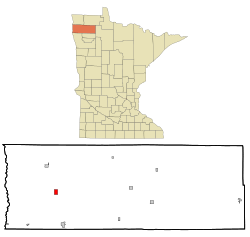Argyle, Minnesota facts for kids
Quick facts for kids
Argyle
|
|
|---|---|
| Motto(s):
Small town living with big city access.
|
|

Location in Minnesota
|
|
| Country | United States |
| State | Minnesota |
| County | Marshall |
| Incorporated | 1883 |
| Area | |
| • Total | 1.51 sq mi (3.91 km2) |
| • Land | 1.51 sq mi (3.91 km2) |
| • Water | 0.00 sq mi (0.00 km2) |
| Elevation | 846 ft (258 m) |
| Population
(2020)
|
|
| • Total | 544 |
| • Estimate
(2021)
|
545 |
| • Density | 360.74/sq mi (139.25/km2) |
| Time zone | UTC-6 (CST) |
| • Summer (DST) | UTC-5 (CDT) |
| ZIP code |
56713
|
| Area code(s) | 218 |
| FIPS code | 27-02134 |
| GNIS feature ID | 0639435 |
Argyle is a small city in Marshall County, Minnesota. It is located right next to the Middle River. In 2020, about 544 people lived there. A fun place called Old Mill State Park is also close by.
History of Argyle
How Argyle Was Founded
Before 1879, a French-Canadian man started a town called Louisa. He named it after a French king. This town was right where a new railroad was planned.
However, James J. Hill bought the Great Northern Railway in 1879. His company decided to build the new railroad town a bit south of Louisa. They named this new town Argyle.
Early Settlers and Growth
Many of the first people to settle in Argyle were French-Canadians. Other families came from England, Norway, Poland, Sweden, Scotland, and Germany. The people of Argyle always wanted to make their town a great place to live and work.
Even today, Argyle has many businesses. These businesses attract customers from all around the area.
Protecting the Town from Floods
The Middle River, which flows through Argyle, is a branch of the Red River. Sometimes, this river could flood the town. To protect Argyle, a large wall called a dike was built in 1988.
Geography of Argyle
Where Argyle Is Located
Argyle is a small city, covering about 1.51 square miles (3.91 square kilometers) of land. There is no water area within the city limits.
The city is about 40 miles away from Grand Forks, North Dakota and Thief River Falls. It is also about 130 miles from Winnipeg, Manitoba, Canada. Minneapolis is further away, about 360 miles from Argyle.
Land Around Argyle
The land around Argyle is mostly flat. This makes it very good for farming.
Population of Argyle
| Historical population | |||
|---|---|---|---|
| Census | Pop. | %± | |
| 1890 | 306 | — | |
| 1900 | 829 | 170.9% | |
| 1910 | 744 | −10.3% | |
| 1920 | 956 | 28.5% | |
| 1930 | 700 | −26.8% | |
| 1940 | 857 | 22.4% | |
| 1950 | 846 | −1.3% | |
| 1960 | 789 | −6.7% | |
| 1970 | 739 | −6.3% | |
| 1980 | 741 | 0.3% | |
| 1990 | 636 | −14.2% | |
| 2000 | 656 | 3.1% | |
| 2010 | 639 | −2.6% | |
| 2020 | 544 | −14.9% | |
| 2021 (est.) | 545 | −14.7% | |
| U.S. Decennial Census 2020 Census |
|||
How Many People Live Here?
In 2010, there were 639 people living in Argyle. These people lived in 261 households. A household is a group of people living together in one home.
Most of the people in Argyle were White (96.7%). A small number were Native American or from other backgrounds. About 2.7% of the population was Hispanic or Latino.
Age and Families
The average age of people in Argyle in 2010 was 42.3 years old.
- About 26.3% of residents were under 18 years old.
- About 19.7% were 65 years or older.
Many households (57.9%) were married couples living together. Some households had children under 18 (31.8%).
Education in Argyle
The First Schools
The first school in Argyle started on March 16, 1880. The very first classes began in May 1880. Miss Mary Dion was the first teacher, and she taught 18 students.
A new brick school building was opened in 1905. Later, in 1969, an elementary school wing and a library were added. In 1974, the community voted to build a new sports facility for the school.
Stephen/Argyle Central STORM
In the early 1980s, the schools in Argyle and nearby Stephen started sharing teachers. They first shared teachers for counseling, special education, and speech. Over time, they shared many more positions.
By the 1989–90 school year, the school boards from both towns began meeting. They held public meetings to talk about combining their school districts. On January 30, 1996, the Stephen Tigers and the Argyle Eagles officially joined. They became one team called the Stephen/Argyle Central STORM.
The Stephen/Argyle Central STORM is very famous for its high school football team. They won their first state championship in 1999. Then, they won five state championships in a row from 2003 to 2007! They won again in 2009.
See also
 In Spanish: Argyle (Minnesota) para niños
In Spanish: Argyle (Minnesota) para niños

